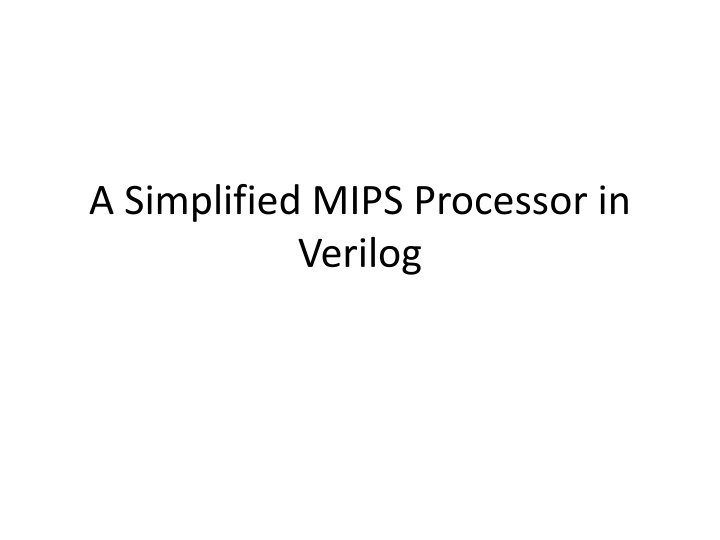
Simplified MIPS Processor Implementation in Verilog
Explore a simplified MIPS processor implementation in Verilog, featuring components like Data Memory module, Instruction Memory module, and Get The Next PC module. Learn about data and instruction memory structures, initialization, and loading a program. Dive into Verilog code snippets for each module and understand their functionalities.
Download Presentation

Please find below an Image/Link to download the presentation.
The content on the website is provided AS IS for your information and personal use only. It may not be sold, licensed, or shared on other websites without obtaining consent from the author. If you encounter any issues during the download, it is possible that the publisher has removed the file from their server.
You are allowed to download the files provided on this website for personal or commercial use, subject to the condition that they are used lawfully. All files are the property of their respective owners.
The content on the website is provided AS IS for your information and personal use only. It may not be sold, licensed, or shared on other websites without obtaining consent from the author.
E N D
Presentation Transcript
A Simplified MIPS Processor in Verilog
Data Memory module DM(MemRead, MemWrite, ABUS, DIN, DATABUS); MemWrite: Nothing happens if 0. If 1, the memory at location ABUS will be written with DIN. ABUS: At any moment, the data at location ABUS will appear at DATABUS. MemRead: Not used.
Data Memory Address bus: 8 bits. Data bus: 32 bits. Each memory location holds 32 bits.
Data Memory Init the contents in data memory with any value you like: initial begin for (i=0; i <= DM_ADDR_MAX_m1; i = i + 1) ram[i] = i*10 + 1; end
Instruction Memory module IM(CSB,WRB,ABUS,DATABUS); CSB: chip select. If 0, selected. If 1, not selected. WRB: Not used. ABUS: Address bus. At any moment, if chip is selected, the data at location ABUS will appear at DATABUS.
Instruction Memory Address bus: 8 bits. Data bus: 32 bits. Each memory location holds 32 bits.
Instruction Memory The most straightforward way of loading a program: ram[0] = 32'b00100000000000000000000000000000; // addi $0, $0, 0 ram[1] = 32'b00100000001000010000000000000001; // addi $1, $1, 1 ram[2] = 32'b00100000010000100000000000000010; // addi $2, $2, 2 ram[3] = 32'b00100000011000110000000000000011; // addi $3, $3, 3 ram[4] = 32'b00000000000000000000000000000000; // nop ram[5] = 32'b00000000000000000000000000000000; // nop ram[6] = 32'b00000000000000000000000000000000; // nop ram[7] = 32'b00000000000000000000000000000000; // nop ram[8] = 32'b00000000000000000000000000000000; // nop ram[9] = 32'b00000000000000000000000000000000; // nop
Get The Next PC module getNextPC (PCSrc, currPC, offset, out); parameter MIPS_PC_WIDTH_m1 = 7; input PCSrc; input [MIPS_PC_WIDTH_m1:0] offset; input [MIPS_PC_WIDTH_m1:0] currPC; output reg [MIPS_PC_WIDTH_m1:0] out; always @(PCSrc, currPC, offset) if (PCSrc == 0) out <= currPC + 1; else out <= currPC + 1 + offset; endmodule
PC module MIPSPC(clk, newPC, PC); Just an 8-bit D-flip-flop.
Register File module MIPSREG(clk, RegWrite, ReadAddr1, ReadAddr2, WriteAddr, ReadData1, ReadData2, WriteData); Just as what specified in the book. RegWrite: If 0, disable write. If 1, register WriteAddr register WriteAddr will be overwritten with WriteData. At any time, ReadData1 is the content of reg ReadAddr1, and ReadData2 is the content of reg ReadAddr2.
ALU module MIPSALU (ALUctl, A, B, ALUOut, Zero); input [3:0] ALUctl; input [31:0] A,B; output reg [31:0] ALUOut; output Zero; assign Zero = (ALUOut==0); //Zero is true if ALUOut is 0; goes anywhere always @(ALUctl, A, B) //reevaluate if these change case (ALUctl) 0: ALUOut <= A & B; 1: ALUOut <= A | B; 2: ALUOut <= A + B; 6: ALUOut <= A - B; 7: ALUOut <= A < B ? 1:0; 12: ALUOut <= ~(A | B); // result is nor default: ALUOut <= 0; //default to 0, should not happen; endcase endmodule
Sign Extension module SignExtend (in, out); input [15:0] in; output [31:0] out; assign out[15:0] = in[15:0]; assign out[31:16] = in[15]; endmodule
Two-to-one Selector module STwoToOne32 (sel, in0, in1, out); input sel; input [31:0] in0, in1; output reg [31:0] out; always @(sel, in0, in1) if (sel == 0) out <= in0; else out <= in1; endmodule
Control module MIPSCtrl (instr, RegDst, ALUSrc, MemToReg, RegWrite, MemWrite, MemRead, branch, ALUCtrl); Take the 32-bit instruction, generate the control signals.
Supported instructions add, sub, addi, lw, sw, beq.
Stepping through the program The clock is set to be 200 time units. Run 200 every time. Check the values of the wires in the waveform Check the content of the registers and data memories in the memory windows.
The waveform after two instructions 00100000000000000000000000000000; // addi $0, $0, 0 00100000001000010000000000000001; // addi $1, $1, 1
